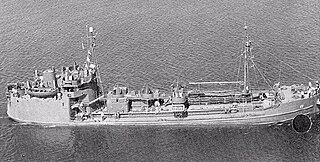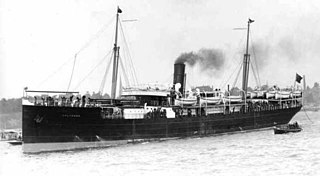
The Japanese raiders in the Indian Ocean were those vessels used by the Imperial Japanese Navy (IJN) during the Second World War to pursue its war on Allied commerce in that theatre. Possessing a powerful fleet of warships, prior to the start of World War II, the IJN had strategically planned to fight a war of fleet actions, and as a consequence delegated few resources to raiding merchant vessels. Nevertheless, in 1940, two passenger-cargo vessels – Aikoku Maru and Hōkoku Maru – of the Osaka Shipping Line were requisitioned for conversion to armed merchant cruisers (AMC)s, in anticipation of the likely thrust southward by the Japanese. These vessels were subsequently used as merchant raiders attacking Allied commercial shipping along vital sea lanes of communication between Australia and the Middle East. Using their comprehensive armament and speed to their advantage, the raiders experienced a brief period of success. Japanese raiding in the Indian Ocean largely ceased by the end of 1942 after an action with a Dutch vessel, the Ondina and a Royal Indian Navy corvette, HMIS Bengal in which the Hōkoku Maru was sunk.

Hoga (YT-146/YTB-146/YTM-146) is a United States Navy Woban-class district harbor tug named after the Sioux Indian word for "fish." After World War II, the tug was known as Port of Oakland and then City of Oakland when she was a fireboat in Oakland, California.

Edward M. Cotter is a fireboat in use by the Buffalo Fire Department at Buffalo, New York, United States. Originally named William S. Grattan, it was built in 1900 by the Crescent Shipyard of Elizabeth Port, New Jersey. Due to age, it was rebuilt in 1953 and renamed Firefighter upon its return to service. The following year it was renamed Edward M. Cotter. its namesake, Edward Cotter, was a Buffalo firefighter and leader of the local firefighters union who had recently died.

Fire Fighter is a fireboat which served the New York City Fire Department from 1938 through 2010, serving with Marine Companies 1, 8 and 9 during her career. The most powerful diesel-electric fireboat in terms of pumping capacity when built in 1938, Fire Fighter fought more than 50 major fires during her career, including fires aboard the SS Normandie in 1942 and the SS El Estero in 1943, the 1973 collision of the Esso Brussels and SS Sea Witch, and the terrorist attacks on September 11, 2001.

USS Victoria (AO-46) was an oiler for the United States Navy in World War II, and the second ship to bear the name. She was built in 1917 as SS George G. Henry in San Francisco for the Los Angeles Petroleum Company. During World War I, the ship was requisitioned by the U.S. Navy and employed as USS George G. Henry (ID-1560). Between the two world wars and at the beginning of the second, she served as a civilian tanker, initially under American registry, but later under Panamanian registry.
Vector was a Philippine oil tanker that collided with the passenger ferry Doña Paz on December 20, 1987 in the Tablas Strait, Philippines, resulting in the deaths of an estimated 4,386 passengers and crew from the two ships. The incident is considered the deadliest peacetime maritime disaster in history.

W. L. Steed was a steam tanker built in 1917–1918 by Bethlehem Shipbuilding Corporation of Quincy for Pan American Petroleum and Transport Company, with intention of transporting oil and petroleum products between Mexican and Gulf ports and the Northeast of the United States. The ship was briefly requisitioned by the US Government during World War I but returned to commercial service in early 1919. The ship was named after William L. Steed, superintendent of the Mexican Petroleum Company of California.
Sylvan Arrow was a steam tanker built in 1917–1918 by New York Shipbuilding Co. of Camden for Standard Oil Company, with intention of transporting oil and petroleum products between United States and ports in the Far East. The ship was briefly requisitioned by the US Government during World War I but returned to commercial service in early 1919.
Esso Brussels was a commercial oil tanker built for the Esso Oil company in 1959. She was involved in a collision in 1973 in which thirteen of her crew perished. She was rebuilt and sailed under various other names until being scrapped in 1985.

The attack on Aruba was an attack on oil installations and tankers by Axis submarines during World War II. On 16 February 1942, a German U-boat attacked the small Dutch island of Aruba. Other submarines patrolled the area for shipping and they sank or damaged tankers. Aruba was home to two of the largest oil refineries in the world during the war against the Axis powers, the Arend Petroleum Company, situated near the Oranjestad harbor, and the Lago Oil and Transport Company at the San Nicolas harbor. The attack resulted in the disruption of vital Allied fuel production.
The Venpet–Venoil collision was a maritime accident involving sister supertankers; the Liberian-registered Venoil and Venpet, in dense fog off the coast of South Africa on 16 December 1977. The tankers were travelling in opposite directions; the Venoil fully laden with over 250,000 tonnes of crude oil bound for Halifax, Canada, and the Venpet, travelling in ballast, headed for Kharg Island, Iran. The Venoil ploughed into the Venpet, eventually leading to the spilling of approximately 26,600–30,500 tonnes of crude oil. The tankers were sister ships owned and operated by Bethlehem Steel Corporation. Both ships were manned by Taiwanese crews.

SS El Estero was a ship filled with ammunition that caught fire at dockside in New York Harbor in 1943, but was successfully moved away and sunk by the heroic efforts of tugboat and fireboat crews, averting a major disaster.

The Abram S. Hewitt was a coal-powered fireboat operated by the Fire Department of New York City from 1903 to 1958. She was the department's last coal-powered vessel and had a pumping capacity of 7,000 gallons per minute.

The T1 tanker or T1 are a class of sea worthy small tanker ships used to transport fuel oil before and during World War II, Korean War and Vietnam War. The T1 tanker classification is still in use today. T1 tankers are about 200 to 250 feet in length and are able to sustain a top speed of about 12 knots. The hull designation AO is used by the US Navy to denote the ship is a T1 oil tanker and AOG that the T1 is a gasoline tanker. The small size allows the T1 to enter just about any sea port or to anchor around a small island, this was very useful during the Pacific War. The T1 tanker can carry about 48,000 to 280,000 bbls. Some T1 tankers were used to transport goods other than oil, a few were used for black oil-crude oil, diesel, chemicals and rarely bulk cargo like grain. T1 tankers are also called liquid cargo carriers. The T1 tanker has about a 6,000 to 35,000 deadweight tonnage (DWT) of cargo. The small size also gives the ships short turn around time for repair, cleaning, loading and unloading. A T1 tanker carrying dirty cargo, like crude oil needs a few weeks of labor to clean before carrying clean cargo. Most T1 ships during World War II were named after major oil fields.

The Fire Department of New York operated a fireboat named William J. Gaynor from 1914 to 1961.
In June 1966, the British oil tanker MV Alva Cape caught fire twice in New York Harbor, first in a collision with tanker SS Texaco Massachusetts, and next while unloading cargo, and was subsequently scuttled offshore. Thirty-three people were killed in the collision, the resulting spill of its cargo of naphtha and major fire that ensued. Four more were killed about two weeks later while the emptied tanks were being inerted with carbon dioxide in a misguided attempt to make the damaged vessel safe for transport.

Lightburne was a steam tanker built in 1918–1919 by Texas Steamship Company of Bath for The Texas Company, with intention of transporting oil and petroleum products between Mexican and Gulf ports and the Northeast of the United States. The ship was named after R. W. Lightburne, Jr., a Kansas City-based steamship agent who rendered valuable assistance to the United States Shipping Board during the war.
R. W. Gallagher was a steam turbine-powered tanker built in 1938 by Bethlehem Shipbuilding Corporation of Quincy for Standard Oil Company of New Jersey with intention of operating between the oil-producing ports of the southern United States and Mexico and the Northeast. The tanker spent her entire career in coastwise trade and was torpedoed and sunk on one of regular journeys in July 1942 by German submarine U-67.













